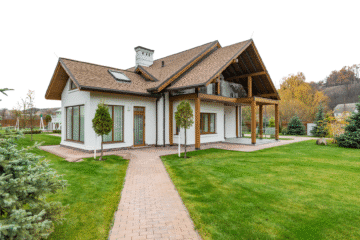Why Roof Cleaning Matters Before Winter
In the Pacific Northwest, your roof works hard year-round — from heavy fall rains to moss-friendly moisture. Over time, organic buildup like moss, algae, and debris can compromise your roof’s integrity, shorten its lifespan, and lead to costly water damage.
According to the National Association of Home Builders (NAHB), routine roof maintenance can extend the life of asphalt shingles from 15 years to more than 25. The Roof Cleaning Institute of America (RCIA) also notes that untreated moss and algae can reduce a roof’s efficiency and lifespan by as much as 40%.
Fall is the ideal time to schedule professional roof cleaning. It ensures your roof is ready to handle months of wet weather and protects your home from leaks, rot, and structural issues.
Here are the top five warning signs your roof needs cleaning before winter hits.
1. Moss or Algae Growth Is Visible
If you see green patches, streaks, or fuzzy moss growing on your shingles, it’s time to act. Moss and algae thrive in damp, shaded areas — a common condition in Western Washington.
Left untreated, moss roots lift shingles, allowing water to seep beneath them. The Asphalt Roofing Manufacturers Association (ARMA) warns that this can void roof warranties and cause premature material failure.
Why Timing Matters:
Moss and algae spread faster in cool, wet weather. Cleaning before winter stops growth before moisture and freezing temperatures make removal more difficult.
2. Dark Streaks or Stains on Shingles
Those dark streaks often seen on asphalt shingles aren’t dirt — they’re typically caused by a type of algae called Gloeocapsa magma. According to This Old House, these streaks not only discolor your roof but also feed moss growth and retain moisture, which can damage shingles over time.
Why Timing Matters:
Addressing stains early helps prevent moss from taking hold and keeps your roof looking clean and uniform before months of rain intensify the problem.
3. Debris Accumulation in Valleys or Gutters
If you notice pine needles, leaves, or twigs collecting in roof valleys, gutters, or near vents, it’s a sign that your roof needs attention. Debris traps moisture and can prevent proper water drainage, leading to leaks and ice dams when temperatures drop.
The Insurance Institute for Business & Home Safety (IBHS) recommends clearing roof valleys and gutters at least twice per year — more often in wooded areas — to prevent ice dam formation and roof deterioration.
Why Timing Matters:
Before winter, your roof and gutters need to be completely clear to allow rainwater to flow freely. Cleaning both systems together ensures your roof stays dry and damage-free throughout the wet season.
4. Water Spots or Stains Inside the Home
If you’ve noticed water spots on your ceiling or upper walls, your roof may already be compromised. Clogged gutters, moss buildup, or damaged shingles often cause water to back up under the roofline, leading to interior leaks.
According to the Federal Emergency Management Agency (FEMA), minor roof leaks can result in hidden mold growth within 24–48 hours, causing long-term structural and health issues.
Why Timing Matters:
Once interior staining appears, moisture has already penetrated beneath your shingles. Cleaning and inspection before winter help identify and fix issues before they worsen under constant rainfall.
5. Roof Looks Dull, Aged, or Uneven
If your roof appears discolored, patchy, or older than it should, it may be covered in dirt, pollen, and organic residue. A professional cleaning can restore its original color, extend its lifespan, and improve curb appeal — a small investment that pays off in both appearance and protection.
Why Timing Matters:
Cold weather and heavy rains make roof cleaning more difficult and riskier. Scheduling before winter allows for thorough cleaning and inspection in optimal conditions.
The Cost of Waiting
Neglecting roof cleaning can lead to serious damage, including:
- Shingle replacement or roof repairs: $1,000–$10,000+ (HomeAdvisor)
- Water damage restoration: $3,000–$7,000 (Forbes Home)
- Mold remediation: $1,200–$3,500 (U.S. Environmental Protection Agency & Fixr)
Compare that to the average professional roof cleaning cost of $400–$800 (Angi). Prevention is always more affordable than repair.
Why Fall Is the Perfect Time for Roof Cleaning
For Pacific Northwest homeowners, fall offers the ideal window for roof maintenance:
- Temperatures are mild enough for safe, effective cleaning.
- Heavy rain hasn’t yet settled in.
- It prevents moss and debris from becoming winter-long problems.
The Pacific Northwest National Laboratory (PNNL) notes that seasonal roof maintenance is especially important in high-moisture climates, where algae and moss can reduce energy efficiency and lead to hidden water infiltration.
Professional vs. DIY Roof Cleaning
While DIY cleaning might seem cost-effective, it comes with serious risks. Roofs are slippery, steep, and require the right cleaning solutions and pressure levels to avoid damage.
OSHA reports that ladder and roof falls are among the leading causes of home-related injuries in the U.S. Professional services like Johnny Tsunami’s ensure your roof is cleaned safely, thoroughly, and according to manufacturer recommendations.
Professional Roof Cleaning Includes:
- Safe, low-pressure soft washing (no damage to shingles)
- Moss and algae treatment and prevention
- Full debris removal
- Inspection for damage or wear
- Cleanup of surrounding areas
Protect Your Home Before Winter Hits
Don’t wait until moss turns into moisture damage. Schedule your fall roof cleaning today and ensure your home is ready for the season ahead.
Johnny Tsunami’s award-winning team provides professional roof cleaning throughout Kitsap County and across Western Washington. We help homeowners extend the life of their roofs, prevent costly repairs, and maintain beautiful, protected homes year-round.
Schedule your roof cleaning today and start the winter with confidence.









